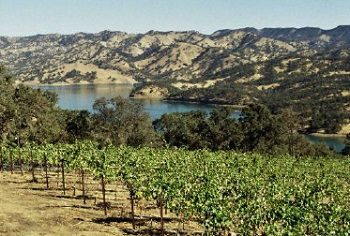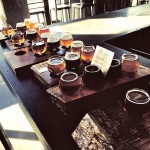St. Barthelemy Cellars: A Port-Only Winery Defining the Odds

Bart Barthelemy, Proprietor, and Winemaker of St. Barthelemy Cellars started his port-only winery against all odds. After all, Napa is most famous for its Cabernet Sauvignon. “We felt that our location was just a bit warm for a top-quality Cabernet vineyard, but would probably do well with grapes and a wine style that needed the higher heat,” Barthelemy says.
Today, St. Barthelemy produces some of the best ports in Napa Valley.
CRUSHBREW: Can you tell our readers how you got started and what motivated you to start a vineyard?
BART BARTHELEMY: After spending some 30 years as “professional consumers,” my wife and I decided to spice up our retirement and get into the business that had attracted us for so many years. We have a gorgeous 40-acre rolling oak tree-studded hillside parcel overlooking Lake Berryessa in eastern Napa County which, at the time, was supporting a few horses.
After helping a neighbor – who was a home winemaker — plant a small vineyard and seeing the resulting wine he produced, we decided that maybe we should try the same thing. Taking our passion and experience in wine tasting to the next level, we broadened our abilities by enrolling in the excellent Viticulture and Wine-making courses at the Napa Valley College.
CB: Your original goal was always to be a port-only winery. Why did you make that choice and how has it affected the quality and quantity of wines you produce?
BB: Napa didn’t really need another Cabernet Sauvignon! However, we had always loved Port wine but felt that the American wineries producing Ports were erroneously following the Portuguese formula which didn’t do justice to the wonderful grape varieties which have traditionally been used to make wine in America.
To follow our idea for a new style of Port wine, we cleared about 18 acres of oak trees and planted the first 6½ acres with four varieties that might do well: Cabernet Sauvignon, Syrah, Zinfandel and Petite Sirah. The initial Cabernet Sauvignon grapes did not reach the quality we desired so we budded over that portion of the vineyard to more Syrah (which was really exceptional) and a small bit of Viognier. Having our own vineyard allows us to farm the grapes for the maximum intensity of flavors needed to produce an outstanding Port wine.
CB: Your wine is fortified at a lower residual sugar level than most other ports. Can you tell our readers a bit more about that? How does that affect taste/texture and the production process?
BB: Our goal was to produce a food-friendly port wine. The traditional Portuguese formula is a wine with 12-15% residual sugar and an alcohol level of 19-21%. The various grape varieties blended into Portuguese ports are generally not as fruity as those used in American wines, but they do have the characteristic of developing a nutty, caramel, butterscotch flavor profile as they age. A delightful wine but not very food-friendly, hence the old adage that ports only go with “cheese and chocolate.”
Virtually all American port producers either follow the Portuguese formula of grape varieties and style, or they fortify some wines made with our traditional grape varieties to the Portuguese style of high sugar and high alcohol. The result is usually a tasty sweet wine that the consumer cannot readily identify and that does not pair with most foods. Lowering the residual sugar to the 5-8% range and using a single varietal in each port would unleash the fruit flavors of the grape and allow the consumer to readily identify the grape. With the lower sugar levels, we had to lower the alcohol to the 18-18.5% range to keep the wines in balance. And the result is a wine that is tasty and food-friendly. With the lower sugar levels, the varietal character of the grape comes through and enables talented chefs to pair our ports with a wide variety of dishes. In fact, we are the only winery in the United States which hosts all-port winemaker dinners, on the Napa Valley Wine Train and other locations around the country. One of our recent diners was at Pebble Creek in Goodyear, AZ.
To accomplish that, first of all, we start with slightly over-ripe grapes with sugar levels above 28o brix. After an extended maceration which raises the sugar levels to the 32o brix range, we do a slow fermentation to allow the maximum skin-juice contact since the fermentation will be cut short by the fortification. As the sugar levels descend through the 12% range we begin a measured fortification using high-proof (160-180 proof) alembic double-distilled grape brandy to slow the fermentation to a gradual stop in the desired 6-8% range. Because the Portuguese start with lower grape sugar levels (after all Portugal is the same latitude as New York and they have trouble getting the high sugar levels we can attain in California) and are seeking a higher residual sugar level, their fortification ratio is approximately 25% brandy to 75% wine. Our fortification ratio is slightly less than 10% brandy which leads to much less flavor dilution.
CB: If you had to pick a favorite among the wines you produce, which one would it be and why?
BB: It is difficult to pick one from the seven ports we produce as they are all very different and I enjoy them all at different times and with different foods. I love cheese and I often have a glass of Barbera Port with some cheese before dinner. My wife cooks a mean Chinese stir-fry and we always have some Syrah Port with that dinner. For dessert, she often poaches pears in the Zinfandel Port. And of course, the most unusual pairing that I love is our Petite Sirah Port with chips and a fruit-based salsa.
But if I have to choose a favorite, I probably must say that our Pinot Noir Port is the favorite because it is the only Pinot Noir Port produced in California and everyone told me that it couldn’t be done. It is delightful with any kind of fruit dish.
















